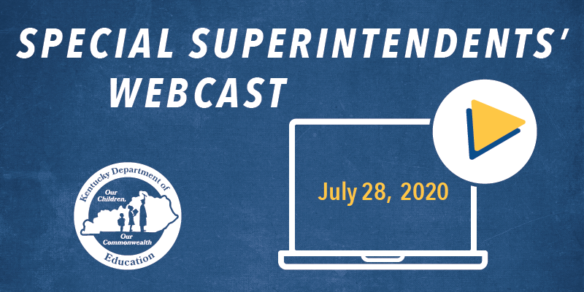
By Jim Gaines
jim.gaines@education.ky.gov
A system of contact tracers should be deployed in almost every local health department in Kentucky by the end of July, according to Mark Carter, executive adviser to the Cabinet for Health and Family Services.
Before COVID-19 hit, there were about 430 people in health departments statewide doing disease investigation and contact tracing, he said during the Special Superintendents’ Webcast on July 28. Historically, those tracers focused on diseases such as HIV and tuberculosis, he said.
But many more qualified staff were needed to help control COVID-19. Contact tracing staff has more than doubled, and by the time school is scheduled to restart, another 260 tracers should be added, Carter said.
He walked through what contact tracers would and wouldn’t ask when investigating a COVID-19 case at a school. Real contact tracers will never ask someone’s Social Security number, passwords, banking information or immigration status, Carter said.
“We’ve been really concerned about fraud,” he said. Anyone asked for those details, instead of where someone has been or who they’ve been with, should hang up and report it to the Kentucky Attorney General’s office, Carter said.
There’s lots of misinformation on social media, but the Contact Tracing and Tracking communications team has developed lots of trustworthy materials, he said. Most of it is available at kycovid19.ky.gov. Local health departments and the state Department for Public Health (DPH) can provide it as well.
Healthy at School Revision
A one-page revision of the DPH and Kentucky Department of Education’s (KDE) flagship Healthy at School guidance document is being issued in response to new recommendations from the U.S. Centers for Disease Control and Prevention (CDC), said Dr. Connie White, DPH deputy commissioner.
In previous webcasts, many school districts have asked if they could install plexiglass dividers in classrooms. Health officials initially opposed that idea out of concern for cleaning time, secure installation and possible sharp edges.
But if plexiglass shields are securely mounted, have no sharp edges and are regularly cleaned, they will be allowed, White said.
Emily Messerli, DPH immunization branch manager, said plexiglass shields could be used in classes with young children or special needs students who may have difficulties wearing masks. The dividers should not be used just to fit more students in a classroom, she said.
White said dividers provide an extra layer of protection, but they are no substitute for maintaining a 6-foot distance, so if students are closer than that they still will need to wear masks.
Guidance from the CDC also has changed and that is incorporated in the Healthy at School revision, White said. Previously, people who tested positive for COVID-19 had to wait at least 10 days since symptoms appeared and go 72 hours without fever – and without use of fever-reducing medication – before returning to school.
While people still must wait 10 days after the onset of symptoms, they now only need to be fever-free for 24 hours, White said. A negative COVID-19 test is not required for return to school, she said.
Finally, the original guidelines to send home anyone with a cough inadvertently included people with pre-existing conditions that can cause a chronic cough, such as asthma, White said. The new rule is to send home only those with a “new, uncontrolled cough” which causes trouble breathing, she said.
COVID-19 Rates Rising
Dr. Deborah Birx, White House Coronavirus task force coordinator, was in Kentucky on July 26 as a “sign of concern” about the rising rate of COVID-19 cases here and in surrounding states, said Interim Commissioner of Education Kevin C. Brown. He hopes Gov. Andy Beshear’s renewed restrictions, announced July 27, will help bring the infection rate down so school can resume. For now, it is the governor’s recommendation that in-person classes start no sooner than Aug. 17.
Other countries have brought COVID-19 rates down through diligent mask use, fast contact tracing and quarantining, and Kentuckians can do the same, White said.
“We can see them go down as quickly as the 17th of August. This can be done,” she said.
Reopening schools won’t be possible unless communities respect health guidance, Messerli said. Schools, superintendents and teachers need to communicate to the public that if they want their kids in school, social distancing and mask-wearing are vital, she said.
“It’s a community effort to get the children back into school,” Messerli said.
Brown stressed the risk of traveling to COVID-19 hot spots, not just for students but also for school employees. Gov. Beshear recommends that athletes and school staff who travel for events to a state with a positive COVID-19 test rate above 15% should self-quarantine upon their return, White said.
Food Service Guidance
Two more guidance documents on school reopening have been released, for a total of 18 so far. One is on “Food Service Operations – Waivers for USDA School Meal Programs” after the U.S. Department of Agriculture (USDA) issued several nationwide waivers for meal programs that last through June 30, 2021.
The added flexibility is different from how food was distributed in spring 2020, said Lauren Moore, KDE’s director of the Division of School and Community Nutrition. The waivers allow food service to enrolled students on days instruction occurs, whether in person or remotely, she said.
The standards are subject to further change, Moore said.
For now, meals can be served during a planned school day, whether in person or through non-traditional instruction (NTI), but not during planned closures, such as weekdays or holidays, Moore said. The state still is seeking guidance from the USDA on whether meals can be offered during unanticipated closures, such as cancellation due to COVID-19, she said.
The waivers do not allow community feeding models such as those used in the spring, said Kathryn Embree, KDE’s school meal programs branch manager in the Division of School and Community Nutrition. There are three models for feeding during NTI:
- Meal pick-up services, in which a student or their parent or guardian picks up food at school and takes it home, preferably in a “drive-through” style or with staggered pick-up times;
- Sending meals home with students during an in-person instruction day for consumption on following NTI days; or
- Offering meal delivery at normal bus stops or direct to households.
For all methods, schools must have ways to keep track of meals and prevent duplication, Messerli said.
Staffing Flexibility
The second new guidance is “Flexibility for Assigning Staff in the COVID-19 Instructional Setting,” which comes in response to staffing concerns from several school administrators, said Associate Commissioner Rob Akers of KDE’s Office of Educator Licensure and Effectiveness.
Districts can use a digital learning provider such as Apex, Edgenuity or Odysseyware to deliver instruction, and any teacher certified on the content and population can serve as Teacher of Record to facilitate those courses, he said. Any certified teacher can serve as an additional instructor when needed, such as when the primary teacher is appearing on video in one classroom to allow for social distancing.
There is some flexibility in allowing teachers to teach up and down grade levels, he said. Those with 1-8 elementary certification can teach all subjects up to 8th grade. Others are more restricted in what they can teach, but districts can apply for emergency certification if there are no qualified candidates to teach a subject.
Any questions can be directed to KDE’s Crystal Hord, Todd Davis or Akers.
Questions & Answers
Question: What’s the decision from the County Employees Retirement System (CERS) on allowing service credit based on hours worked instead of days?
Answer: Kentucky Retirement Systems (KRS), which oversees CERS, issued a memorandum that suggests as long as classified employees work the same number of hours during a variable student instructional year as they would work in a traditional school year, that will count as a full year of service credit, KDE Interim General Counsel Todd Allen said. Any further questions should be directed to KRS.
Question: If school staff use all their paid time off while out sick, what happens if they’re later told to quarantine?
Answer: School districts have a few options, Allen said. The state Board of Education is expected to approve an emergency regulation allowing districts to provide additional COVID-19-related leave based on locally developed criteria, he said. A recently issued guidance document lays out the options.
Question: Since a high percentage of people carrying COVID-19 show no symptoms, are temperature checks at school doors really useful?
Answer: The CDC says 16% of infected children are asymptomatic, meaning 84% will have some symptom, of which fever is the most common, White said. Temperature checks are the simplest way to catch many people before they enter a school and are in contact with lots of people, she said.
Brown said temperature checks are a logistical challenge, but KDE fully supports the policy. He reiterated the July 1 announcement that 12,500 digital thermometers are being distributed free to schools through area development districts.
MORE INFO …
- July 28 Special Superintendents’ Webcast
- Kentucky Department for Public Health’s COVID-19 webpage
- KDE’s COVID-19 webpage
- KDE’s COVID-19 Reopening Guidance webpage
- Kentucky COVID-19 Hotline (800) 722-5725



Leave A Comment